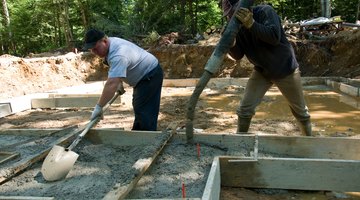How to Pour a Slab on Clay Soil
Concrete is the most used man-made material in the building industry. Made up of gravel, sand, cement and water, concrete provides a stable foundation in building structures and parking slabs.

Concrete slabs are also used as patios and foundations of porches, decks, sheds and home appliances such as the central heating unit. Sometimes materials such as rebar may be added into slab forms before pouring for more strength. Sand and clay soils need extra preparation before pouring the slab for support and longevity.
Things You Will Need
- 1-by-6-inch pieces of lumber to build forms
- Saw
- Level
- Gravel
- Rake
- Concrete mix
- Water
- Mechanical mixer
- 2x4 piece of lumber for leveling concrete
-
Level the are where the slab will be poured with a rake.
-
Cut the 1-by-6-inch pieces of lumber to frame the slab area with wood to make a concrete form. Do this by staking off the corner dimensions of the intended slab. Then attach boards to the stakes and each other at the corners with screws.
-
Add a 4-inch layer of gravel atop of the soil inside the form to provide extra support for the slab when pouring over poor draining soil such as clay or sand. Level the gravel layer with a rake. This should end up being about 2 inches from the top of the concrete form.
-
Add structural steel rebar for support if needed. Rebar is placed on top of the gravel inside the form in a grid pattern approximately one foot apart. Then use wire to join the grid at the intersections. If the slab is for a home foundation or parking area, adding the rebar is a good idea to prevent cracking later.
-
Mix the concrete powder mix with water. Add approximately 5 or 6 gallons of water per 94 lb. bag of cement. Concrete mix should be somewhat thick. If you make a channel into the mix with your shovel, the concrete mix should stay and not fill back up into the channel or crumble. This is the correct consistency. Renting a mechanical mixer from the local home improvement center may be in your best interest. A mechanical mixer will make the job easier and ensure the concrete is completely mixed for the best results.
-
Level the concrete to the top of your forms by sliding a 2x4 evenly across the surface to smooth and compact.
-
Let the concrete cure for at least 24 hours before removing the wooden forms. Concrete will continue to cure over the next few days as the moisture evaporates.
Tip
Avoid pouring concrete in extremely hot or cold temperatures. The temperature can adversely affect the mixture and increase curing times.
The Drip Cap
- Concrete is the most used man-made material in the building industry.
- Add a 4-inch layer of gravel atop of the soil inside the form to provide extra support for the slab when pouring over poor draining soil such as clay or sand.
- Level the gravel layer with a rake.
- Mix the concrete powder mix with water.
- Add approximately 5 or 6 gallons of water per 94 lb.
- A mechanical mixer will make the job easier and ensure the concrete is completely mixed for the best results.
References
Writer Bio
Amanda Ballard Coates is a Certified Professional Coder (CPC) and a member of the American Association of Professional Coders. She is also a freelance writer and photographer. She writes mostly nonfiction and has been published on several informative websites. Ballard Coates' writing has been published on websites such as Healthmad.com, Quazen.com, Gomestic.com and Socyberty.com.
Photo Credits
- Jupiterimages/Photos.com/Getty Images
- Jupiterimages/Photos.com/Getty Images
More Articles



